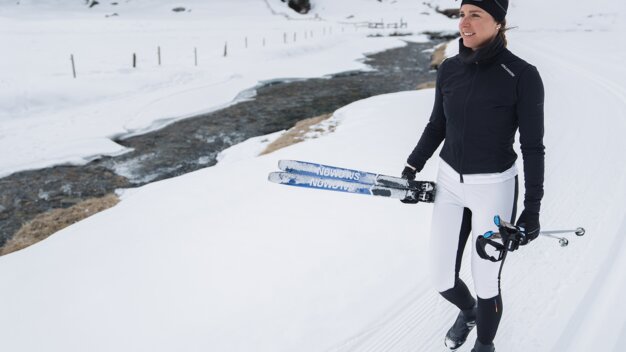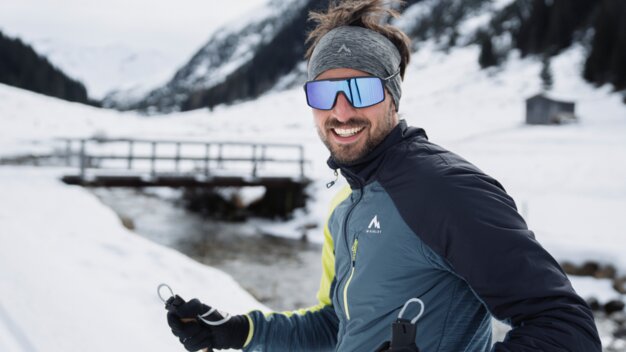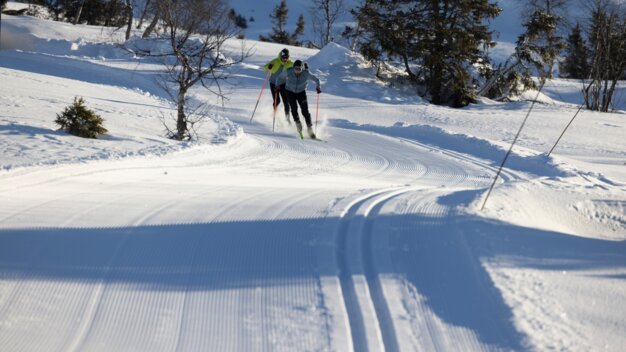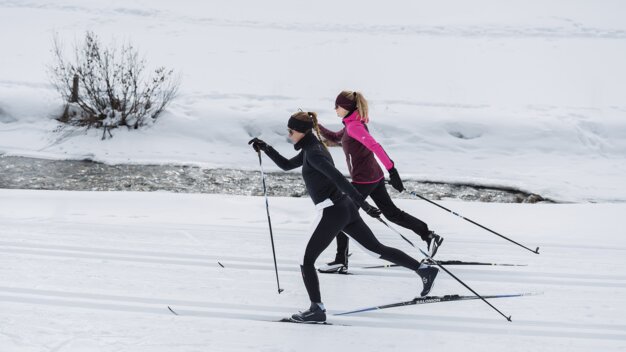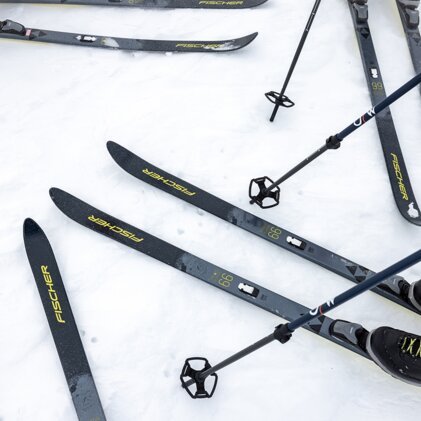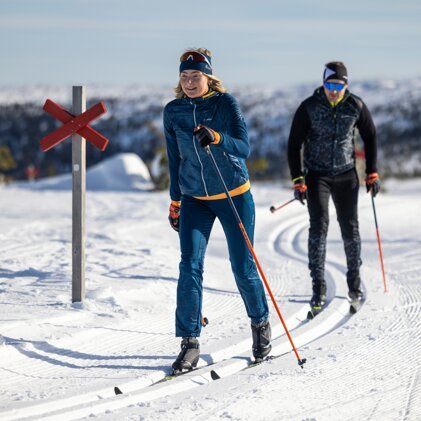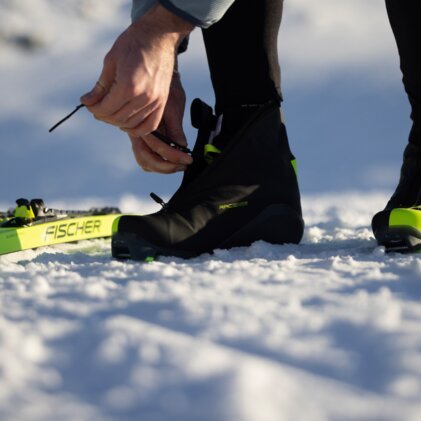
Cross-country skiing is a popular but also physically demanding sport. To enjoy your time on the cross-country ski trails, you need an outfit that perfectly supports you. There are a few things you should take into account when choosing clothing for cross-country skiing – especially if you’re new to the Nordic sport.
Read on for some useful tips on choosing the right outfit and garment care – for maximum protection and a carefree time on the cross-country trails!
The perfect outfit for cross-country skiing
To be perfectly prepared for your cross-country skiing adventure, you need the right clothing. For this sport, it’s best to dress in layers. Usually, three clothing layers are used to form a perfect outfit.
1st layer: base layer
The first layer is the one closest to your body and in direct contact with your skin. That’s why it should fit snugly and have good moisture management. Some of the best choices include functional underwear made of synthetic fibres or merino wool.
A good base layer also includes cross-country ski socks with good moisture management and a perfect fit.
Our tip for those with cold feet:
Do you easily get cold toes or always have cold feet? Choose loose-fitting cross-country ski boots or slightly loosen your laces – this stimulates circulation!
2nd layer: mid-layer
The main task of the mid-layer is to keep you warm. How much you want to protect yourself from the cold depends on the temperatures on site and on your sensitivity to cold temperatures. Options include long-sleeved shirts as well as lightweight softshell jackets, some of which can be adjusted with zips.
A frequently asked question:
Some mid-layers have brushed insides – and for good reason. These garments are softer to the touch and provide improved thermal performance.
3rd layer: outer layer
The outer layer protects you from the elements. Special materials and inserts keep you safe from moisture and wind. Options include lightweight jackets and pants with ventilation slits and windproof components. In freezing cold or during cross-country skiing sessions with lower intensity, you can also wear cross-country ski pants.
Cross-country skiing accessories on top
In addition to underwear, shirts, jackets and pants, suitable accessories make your cross-country skiing outfit complete. Essentials for the trail include gloves, a woolly hat or headband, and a scarf.
Our tip: Consider the current weather conditions when choosing your outfit! In freezing cold, the second layer is particularly important. For sleet, a waterproof third layer is essential. And on sunny days, protect your face with sunscreen and special cross-country skiing eyewear.
4 things you should consider when choosing cross-country ski clothing
When choosing or buying clothing for cross-country skiing, there are several things to consider. After all, a poorly chosen outfit can ruin the entire experience. But don’t worry, we have some helpful tips for you!
Don’t wear too many layers!
The principle “Less is more” definitely applies to cross-country ski clothing. Even as a beginner, you are constantly in motion, so it’s best to wear as little as possible. However, you can pack a spare jacket that you can put on if you still feel cold after the first round on the trail.
Don’t repurpose ski clothing for cross-country skiing!
It may sound practical, but we really don’t recommend using cross-country clothing for other purposes. During skiing, there are times when you’re not moving, for instance when you’re waiting for or riding the lift. With cross-country skiing, you don’t get this kind of down-times. If you don’t want to buy any cross-country clothing yet, wear your winter running outfit or your ski touring clothes instead!
Avoid wearing cross-country clothing made of cotton!
We know, cotton garments feel pleasantly soft to the touch. However, for cross-country skiing, cotton is less suitable. The reason: Cotton clothing absorbs sweat quickly but does not release it to the underlying layers like synthetic fibers or merino wool do. This can lead to rapid cooling, and you may start to feel cold from the inside out.
Don’t hit the trail with a bursting backpack!
Spare clothes, a water bottle, snacks, valuables – and your backpack is already pretty full. Even if this makes you perfectly prepared for the trails, you will have less fun with a filled-to-bursting backpack. After all, a bulky backpack can restrict your arm movement with cross-country poles. Instead, opt for a special cross-country skiing belt! For longer tours, consider using hydration belts equipped with an insulating bottle holder and some storage space.
How to care for your cross-country ski clothing
Once you’ve found your favourite cross-country ski outfit, you’ll want to keep it for as long as possible. You can contribute to this by taking proper care of your garments. Do you want to get everything right?
Then follow these tips:
Follow the washing instructions
A look at your garments’ care labels will tell you how to machine-wash them correctly. In general, you should wash cross-country ski clothing at low temperatures (30 to 40 degrees Celsius). The gentle cycle is also recommended. Using a mild, liquid detergent free of fabric softeners or bleach will protect technical fabrics from damage.
Dry your garments properly
Hang cross-country ski clothing to dry instead of putting it in the dryer! The heat from the dryer can affect the elasticity and water-repellent properties of the fabrics. Also, avoid drying the clothing in direct sunlight as this may cause the colours to fade!
Effective stain removal
If you notice stains on your cross-country ski clothing, try to treat them as soon as possible using a mild detergent or special stain removers for technical fabrics. To protect the materials, we advise against using aggressive chemical stain removers.
Maintain the water repellency
Do you want to maintain the water-repellent properties of your cross-country ski clothing? Use special sprays or products to renew the impregnation of your garments! For proper application, follow the instructions of the respective manufacturer.
Storage of your cross-country ski clothing
When the cross-country skiing season is over, store your outfit in a cool and dry place. Storing it in a tightly sealed bag or in direct exposure to sunlight can harm your cross-country ski clothing as this can affect the colours and breathability of the fabrics.
Keep zips and Velcro fasteners closed
Make sure that zips and Velcro fasteners are closed during washing and storage! This prevents them from getting tangled or damaged.
Ready for the cross-country trails
Once you have assembled your perfect outfit, you can strap on your cross-country skis and hit the trails.
Intersport Rent tip
Are you lacking some equipment? Take advantage of the great rental offers at the INTERSPORT Rent shops! It’s the perfect way to try the sport without having to spend a fortune on cross-country skis and other gear.
Related articles
You may also be interested in:
